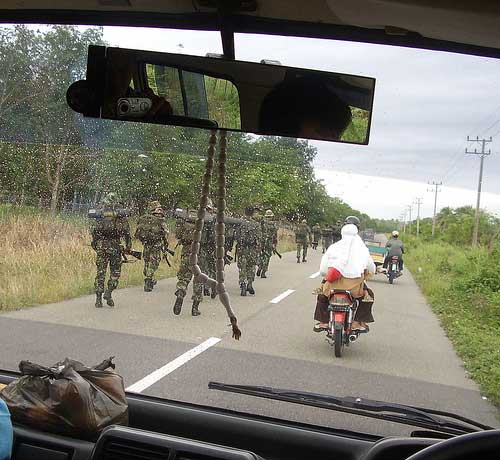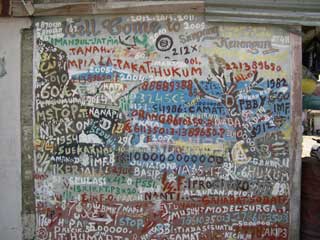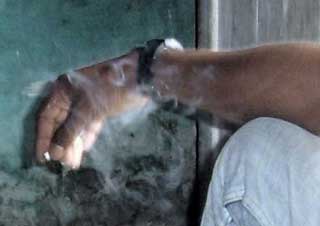Jesse Hession Grayman
A neighbour looks on during an IOM interview
|
Hendra is a 25 year old psychiatric nurse in Aceh. He has been working for the International Organization for Migration’s (IOM) psychosocial support program in post-conflict areas of the province since early 2006. In 1992, a few years into a brutal nine year government crackdown against separatists when the province was declared a Military Operations Zone, Hendra was ten years old and living in a rural area of North Aceh district, not far from Exxon Mobil’s natural gas operations.
One day he and his friends were playing child war games about 300 metres behind his house when they found the bloodied corpse of an unknown man with his neck sliced open and his head almost completely severed from his body. Hendra saw the body and its deadly open wound in full detail, and stood transfixed for a while before running to tell the adults.
That very night, Hendra told me, he was beset with ‘strange and terrifying’ dreams. It was too far in the past for Hendra to remember the details but he does remember waking up every night in fear, unable to fall asleep until morning, sitting in bed in a daze, usually accompanied by his parents to help him feel safe. His parents would usually read Qur’anic verse to help him fall asleep again, and they brought Hendra several times to his religious instructor who gave him water to drink that had been blessed by chanting Qur’anic mantras over it.
After three months of nightmares and prayer sessions every evening, along with periodic visits to the instructor healer, little by little the nightmares went away. Hendra’s own experience has helped him summon the great reserves of empathy required to work with the conflict victims he assists today.
Stumbling inadvertently upon dead bodies is just one of dozens of varieties of traumatic experience that characterised the violence inflicted upon civilians during the worst years of the conflict in Aceh from 1989 until 2005. Hendra’s nightmares resolved in a manner that many traumatic symptoms are typically resolved - over time.
Trauma and dreams
 |
Still a common site in many parts of Aceh
|
Throughout 2006, Harvard Medical School and IOM conducted a psychosocial needs assessment in former high conflict areas in 14 districts of Aceh. The aim was to document patterns of traumatic conflict events in the past and their association with current symptoms of mental illness such as depression and post-traumatic stress disorder (PTSD). In my role as manager of this research I hired, trained, and monitored a team of nearly 50 people who interviewed 1972 randomly selected adults from 106 villages across Aceh. Because nightmares are a signature symptom of PTSD, a section of the questionnaire was dedicated to asking respondents about their recent experience with nightmares and their content. Examining post-trauma nightmares in a therapeutic setting may help patients - individually and collectively - to put the intrusive memories of their past behind them.
However, we found that examining conflict-related nightmares in Aceh poses several challenges. Not only is there no word for ‘nightmare’ in the Acehnese language, but most Acehnese do not think of bad dreams as a sign of psychological distress. They especially do not like to elaborate upon the content of dreams because they are usually the work of devilish spirits (‘jin’) which as a rule should not be indulged. If not the work of jin, most Acehnese interpret their dreams as a private message or truth about the future. Thus the typical post-trauma dream - nightmares that exactly replicate traumatic events from the past - do not fit neatly into most Acehnese understandings of their dreams.
A few examples from our research findings illustrate the profound effects the conflict had on civilian populations. 74 per cent of the sample reported living through combat experiences and 53 per cent had to flee from danger in their community. 39 per cent reported a family member or friend killed. Five per cent of all women in the sample lost their husband due to conflict violence, and four per cent of all respondents lost a child. People were forced to fight (18 per cent) or else punished for not fighting (11 per cent), and forced to search for suspected GAM members in the forest (28 per cent). 13 per cent of respondents were publicly humiliated and five per cent were forced to humiliate another person. 44 per cent of the sample witnessed physical punishment and the qualitative data suggests that this was usually by force and that most physical punishment was accompanied by public humiliation. Women described being forced to watch with their children as their husbands and sons were mutilated and killed. An entire village was forced to watch while a dozen homes were set afire with their residents trapped inside.
During our field research we used the Indonesian phrase ‘mimpi buruk’ (literally, bad dream) when asking respondents about the nightmares related to their conflict experience. When I asked two young Acehnese men how they would translate mimpi buruk into their language they paused, gave me a curious look, and then together they decided upon the circuitous ‘loempoe hana got’ (literally, not a good dream). The absence of an Acehnese term for the concept suggests that dream experiences might not be an important marker of traumatic disorder in Aceh. And yet, when respondents were asked if they had frequent mimpi buruk during the past week, 21 per cent of the sample responded with either ‘sometimes’ or ‘often.’ When asked whether respondents were visited by spirits of the dead in their sleep, 24 per cent of the total sample said yes. 26 per cent of the people we interviewed took the time to tell us more detail about their dreams.
Pleasant and violent dreams
Although the question specifically asks about nightmares, about one third of the responses to this question instead discuss ordinary dreams or dreams that made respondents feel good. Many described visits in their dreams from people who died in the conflict or tsunami. Some respondents went out of their way to correct the interviewer and emphasised that these dreams were not nightmares, but quite the opposite: ‘I dream about my husband and it is pleasant and beautiful, not a nightmare.’ Their comments express pleasure, comfort, wonder, and yearning for more visits with the spouses, children and friends they miss:
|
‘I dreamed that my husband came to visit all of us, he spoke and joked around with the children as if he was still alive. Especially at the end of the fasting month, that’s when I dream most often that my husband comes to visit.’ ‘Once I dreamed that I met my husband and he told me that he would return someday. In my opinion that’s a good dream.’ ‘I dreamed that I was speaking with my son. He was sitting under a tree near the mountain, and he told me that I shouldn’t worry, that he was healthy and has everything he needs.’ ‘I’ve never had nightmares, but I have had dreams about my relative who passed away and I invited him out to sea to go fishing just like we used to do before he died.’ |
For every pleasant dream described in answer to the open question about nightmares, there are as many descriptions of nightmares that repeat a common set of violent conflict events that respondents experienced or witnessed themselves. Troops, usually TNI (Indonesian military forces) or BRIMOB (Indonesian police mobile brigade), but sometimes ‘unknown assailants’ or GAM, enter a respondent’s village and then beat, shoot, capture or kidnap the respondent or the respondent’s close relative or friend, and bring them to the nearest military post, where they are tortured until bloody or dead. Dreams end at the moment when the victim is the most bloody, is in the most pain and screaming, or dies, and the respondent almost invariably wakes up in a ‘cold sweat’ and can not fall back asleep until sunrise.
Other common narratives about the conflict include getting caught in the line of fire during armed battles, and being endlessly chased, stalked, and hunted by the TNI or BRIMOB. Without any special probing questions from the interviewing staff, many respondents volunteered enough information suggestive of the textbook post-traumatic nightmare, a repetition of past events with little or no variation in content, frequently occurring, and terrifying enough to prevent respondents from returning to sleep:
|
‘I dream that my son who joined GAM died after being shot and tortured sadistically by the TNI… he was screaming to me for help and I wake up suddenly and can not fall back asleep.’ ‘I see the dead thrown into the river.’ ‘I dream about the battles in my village, see my father-in-law taken by the TNI and buried alive.’ ‘I see it all over again in my dream, my son being tortured by them. I feel so sad, and this happened every single night, for weeks.’ ‘One day I go off to sell my produce, then I am captured by the security forces, then I am beaten until I am dead. I have this dream often, especially when I’m sick.’ ‘Back in 2005, I would always dream that I was being electrocuted in exactly the same way I saw when my friend was tortured at the military post one year ago.’ ‘I often dream about when I was tortured while held captive at the TNI post and forced into the irrigation canal in front of the post for one day and one night.’ ‘I always dream about the time when BRIMOB caught me and my husband. They beat my husband in front of our house and then they wrote ‘GAM’ on the front wall.’ ‘In the dream it’s as if I am repeating over again the time when I was stripped naked and dragged all around by them on the ground.’ ‘My dream is so terrifying. I see bodies gory and smeared with blood, others decapitated and shot up. What’s so strange about the dream is that these were all things I saw in my village with my own eyes that one time… all this violence carried out by the TNI.’ ‘Every night I dream about the time when I was tortured or when I saw their necks were slit and others were shot on sight by the TNI. After waking up I can’t sleep until the morning.’ |
Fortunately, some respondents (6 per cent) mark their nightmares with the past tense, noting that these vivid and troubling experiences, though once frequent, occur rarely now or have not presented since the violence stopped, for example ‘Yes, I had nightmares about the conflict, but not since the peace agreement.’
No nightmares in Aceh?
Dreams with a message, called ‘loempoe’ in Acehnese, bear truths that tell the dreamer something about the future. These messages - cherished and often held in secret - are an important component of the dream experience in Aceh. People in Aceh rarely talk about their dreams and it can be quite difficult to solicit dream narratives from people in Aceh during ordinary conversation.
Many of the dreams that our respondents reported were loempoe which contained a variety of messages for the dreamer. One woman who described having frequent dreams of being shot dead just like her husband told us that after the peace agreement her husband has visited her often in her dreams and told her not follow him down that path, that he is already too far away. Deceased husbands tell their wives to have patience in facing the difficult future ahead and grant them permission to re-marry. Deceased siblings thank their brothers and sisters for a proper burial and ask them to take care of their surviving children, not to let anyone else take them away, and to always look out for their parents’ welfare. Deceased parents remind their children to pray five times a day and to take care of one another.
The anthropologist James Siegel suggests there is no word for ‘nightmare’ in the Acehnese language because all dreams, apart from ‘true’ loempoe dreams with a message, are unpleasant and by definition brought by jin. The generic term ‘jin’ refers to spirits with bad intentions that range from deceitful tricksters that try to steer people away from piety to indescribably dark and terrifying figures that try to kill the dreamer. Jin are the source of ordinary frightening nightmares, but respondents never attributed their conflict nightmares to jin. A disturbance or temptation brought by jin makes the whole enterprise of interpreting one’s dreams a treacherous exercise because it can be difficult to sort the truths that some dreams reveal from the temptations and lies of a jin. This is why many Acehnese find dreams generally unpleasant - their dreams tease, perplex, and distract.
PTSD can be described as an illness of not being able to forget; the traumatic moment is a memory intrusion and does not discriminate between wakeful and sleep states. The conflict nightmares quoted above are textbook examples of traumatic memory intrusion. Ordinary nightmares, by contrast, can be about anything and people construe their meaning and importance differently according to variable social contexts. In Aceh, people construe their ordinary nightmares as the work of mischievous jin.
Our data shows that survey respondents collectively distinguish between their conflict-related nightmares and other nightmare-like dreams ascribed to the work of jin. This difference is further reflected in respondents’ reported PTSD symptoms by the type of nightmares they described: 48 per cent of respondents who described nightmares based on conflict events met enough symptomatic criteria for a PTSD diagnosis. On the other hand, respondents who talked about ordinary bad dreams which they ascribed to the work of jin were no more likely to report enough symptoms for a PTSD diagnosis than respondents who reported no nightmares at all.
 |
The madness of conflict: graffiti by a roadside in South Aceh
|
Conflict nightmares do not fit into Acehnese categories of loempoe and jin-inspired dreams. Rather, conflict nightmares reflect back to Acehnese dreamers the remnants of political violence which they cannot forget. Here lies perhaps another reason why Acehnese rarely mention conflict nightmares when describing their own psychological distress - conflict nightmares that replay terrifying events of the past are as foreign and unrecognisable in the Acehnese dreamscape as the Indonesian troops that perpetrated the dreamers’ original traumatic moment. If dreams enjoyed in law the status they occupy in psychology, they would constitute a principal piece of evidence in Aceh’s post-conflict pursuit of justice, for these disturbing nightmares are an enduring testament to the systematic campaign of torture and humiliation inflicted upon Aceh’s civilian population. ii
Jesse Hession Grayman (jgrayman@gmail.com) is a PhD candidate in the Department of Anthropology at Harvard University’s Graduate School of Arts and Sciences. The psychosocial needs assessment in post-conflict Aceh, of which this nightmare data is a part, was designed by Professor Byron Good and Professor Mary-Jo Good from the Department of Social Medicine at Harvard Medical School.
